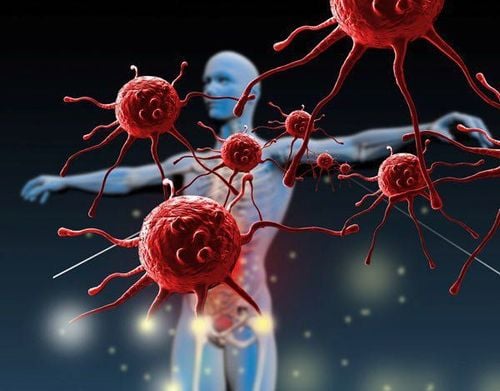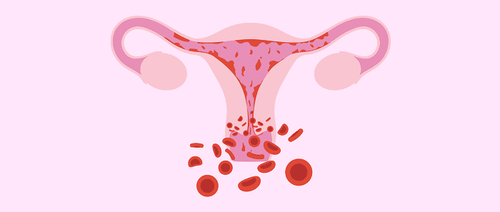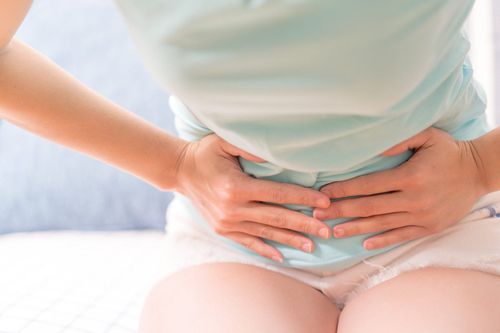This is an automatically translated article.
The article was professionally consulted with Specialist Doctor I Le Khac Hieu - Obstetrician and Gynecologist - Department of Obstetrics and Gynecology - Vinmec Ha Long International General Hospital.Endometriosis is the presence of endometrial cells (the type of tissue that forms the lining of the uterus) outside the uterus, for example in the fallopian tubes, ovaries. Endometriosis can affect women of all ages, causing many unpleasant effects in the community. Current treatments can help women with this problem; Therefore, early diagnosis of endometriosis is essential.
1. What is endometriosis?
Endometriosis is a disease that often causes pain in women because tissue similar to the lining of the uterus grows outside of the uterus. Endometriosis develops most commonly in the ovaries, fallopian tubes, and possibly the pelvis, although less commonly.The physiological progression of endometriosis cells is similar to that of true endometrium, which will also thicken, shed and bleed with each menstrual cycle. However, because blood shed from this tissue has no way of exiting the body, it becomes trapped and causes symptoms. When endometriosis develops in the ovaries, fallopian tubes, cysts of endometriosis will form, causing the surrounding tissues to become irritated, causing an inflammatory reaction, and eventually tissue growth. scarring and adhesion, can cause infertility due to obstruction.
However, fortunately, the means of diagnosing endometriosis are now quite simple and common, especially with ultrasound. At the same time, the current treatment methods also show quite high effectiveness, most women with endometriosis respond quite well.
2. What are the symptoms of endometriosis?

In addition, pain characteristics and common signs of endometriosis include:
Dysmenorrhea: Pelvic cramps and cramping may begin before and last several days on menstruation. The woman may also experience back pain and lower abdominal pain. Pain during intercourse: Pain during or after sex is common with endometriosis. Pain during bowel movements or urination: You are most likely to experience these symptoms during menstruation. Excessive bleeding: The amount of menstrual bleeding in each menstrual cycle is often heavy or sometimes there is bleeding between periods. Miscarriage Delayed pregnancy: Sometimes, endometriosis is diagnosed during infertility treatment. Other signs and symptoms such as fatigue, diarrhea, constipation, bloating or nausea, especially are related to menstruation. However, the severity of the pain may not be commensurate with the severity of the condition. A woman may have mild endometriosis but severe pain or a large amount of endometriosis tissue with little or no pain.
Additionally, the pain in endometriosis is sometimes confused with other conditions that can also cause pelvic pain, such as pelvic inflammatory disease or ovarian cysts. Furthermore, the condition can still be confused with irritable bowel syndrome, a problem that causes diarrhea, constipation, and abdominal cramps. However, irritable bowel syndrome can still accompany endometriosis and can complicate the diagnosis.
3. What causes endometriosis?

Retrograde menstruation: This condition is when menstrual blood contains endometrial cells. The endometrium flows back into the fallopian tubes and into the pelvic cavity instead of needing to exit the body. At this point, endometrial cells stick to the pelvic wall and surfaces of pelvic organs, where they continue to grow and continue to thicken, peel, and bleed throughout each menstrual cycle. next. Peritoneal cell transformation: Studies suggest that hormones or immune factors promote the transformation of peritoneal cells into endometrial-like cells. Embryonic cell transformation: Hormones such as estrogen can transform embryonic cells – cells in the earliest stages of development – into endometrial-like cells during puberty. Scarring surgery: After surgery, such as myometrial incision in cesarean section, fibroid removal, endometrial cells can attach to the incision and the cord sticks out. Endometrial cell transport: Blood vessels or the lymphatic system can transport endometrial cells to other parts of the body. Immune system disorders: Abnormalities in the immune system can prevent the body from recognizing and destroying endometrial-like tissues and allowing them to grow outside of the uterus. In addition, some of the following factors put a woman at a higher risk of endometriosis than other women, such as:
Not having children Early menopause Late menopause Short menstrual cycles , less than 27 days Menstrual period lasts more than seven days Having high estrogen levels in the body or prolonged treatment with estrogen Low body mass index Having one or more close relatives such as mother, aunt or sister who has had endometriosis Uterus Any abnormality that blocks the flow of menstrual blood out of the body Fortunately, endometriosis develops only a few years after menstruation begins and can temporarily improve during pregnancy , which disappears completely with menopause, unless estrogen is still being used.
4. Can endometriosis be diagnosed by ultrasound?

Although the larger the lesion, the easier it is to be seen on ultrasound, with today's advances in ultrasound technology and with experienced radiologists, only a few millimeters of endometriotic tissue is needed. bow can be diagnosed. Lesions of endometriosis on ultrasound will appear darker (considered darker) than the surrounding normal tissue.
Besides ultrasound, magnetic resonance imaging using magnetic fields and radio waves to create detailed images of organs and tissues in the body also helps to look for the presence of endometriosis tissue , especially at positions located deep, hidden behind the viscera or causing inflammation, sticky cords. In addition, laparoscopic pelvic intervention may also be indicated, helping to diagnose and treat locally.
5. How is endometriosis treated?
There is no cure for endometriosis, and in practice it is difficult to treat completely. The goal of treatment is only to relieve symptoms so that the condition does not affect the woman's daily life too much with specific purposes as follows:Relieve pain Slow down tissue growth Endometriosis Improves Fertility Accordingly, your gynecologist will discuss individual treatment options and the benefits and disadvantages of each. To make the right choice, your doctor will need to consider your age and what the main symptoms are, such as pain, menstrual problems or difficulty getting pregnant. However, treatment may not be necessary if symptoms are mild, you have had enough children, or are nearing menopause, when symptoms may get better without treatment. what.
Treatment methods for endometriosis that are being applied today are: Treatment with hormones, to limit or stop the production of estrogen in the body, because estrogen stimulates endometrioma tissue to grow. develop.
Surgical intervention, to remove or destroy areas of endometriosis tissue, can help improve symptoms and fertility. The type of surgery performed depends on the location of the tissue, such as laparoscopy or hysterectomy.
6. What are the complications of endometriosis?

Besides, a scary thing about having endometriosis is the possibility of malignancy. Ovarian cancer occurs at a higher than normal rate in people with endometriosis. This is similar to endometrial adenocarcinoma.
In summary, endometriosis is a fairly common gynecological condition, causing dysmenorrhea, menstrual disorders and even infertility. Fortunately, this disease is now easily diagnosed with ultrasound and treatment methods, helping to preserve reproductive function as well as improve a woman's quality of life.
In order to help customers detect and treat other gynecological diseases early, Vinmec International Hospital has a basic gynecological examination and screening package, helping customers detect early inflammatory diseases Easy, inexpensive treatment. Screening detects gynecological cancer (cervical cancer) early even when there are no symptoms.
Basic gynecological examination and screening package for female customers, has no age limit and may have the following symptoms:
Abnormal vaginal bleeding Having menstrual problems: irregular menstrual cycle, irregular menstrual cycle Irregular vaginal discharge (smell, different color) Vaginal pain and itching Female clients have several risk factors such as poor personal hygiene, Unsafe sex, abortion,... Female customers have other symptoms such as: Abnormal vaginal discharge, itching, pain in the private area, abnormal vaginal bleeding.
Please dial HOTLINE for more information or register for an appointment HERE. Download MyVinmec app to make appointments faster and to manage your bookings easily.














